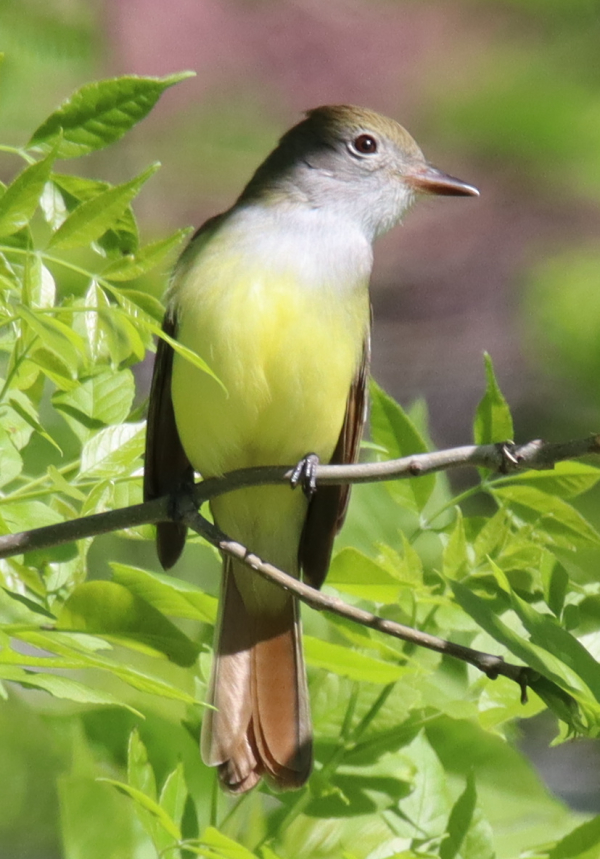
During what turned out to be the last day of spring migration (last Wednesday), a few rare sightings for the area were documented, including this Great Crested Flycatcher, only the second observed at the Grove to date.
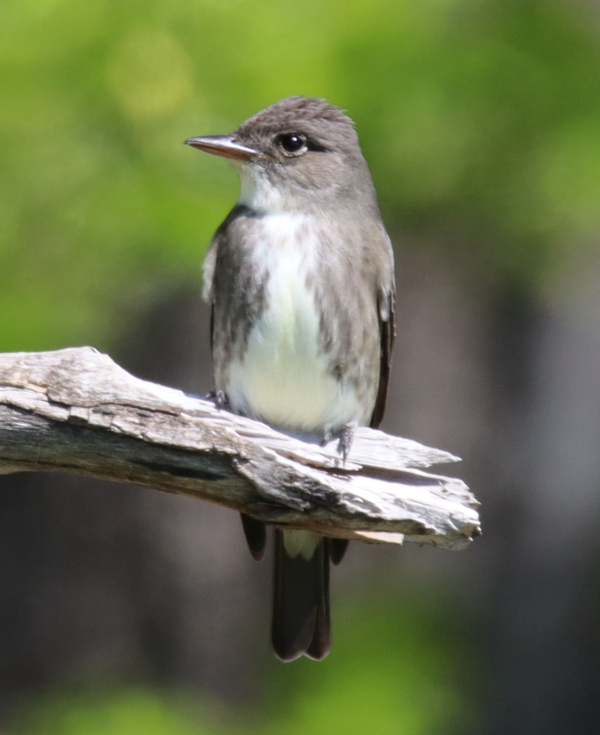
The editor’s first sighting of an Eastern Wood Pewee in the state provided a nice portrait shortly after the Great Crested Flycatcher appeared.
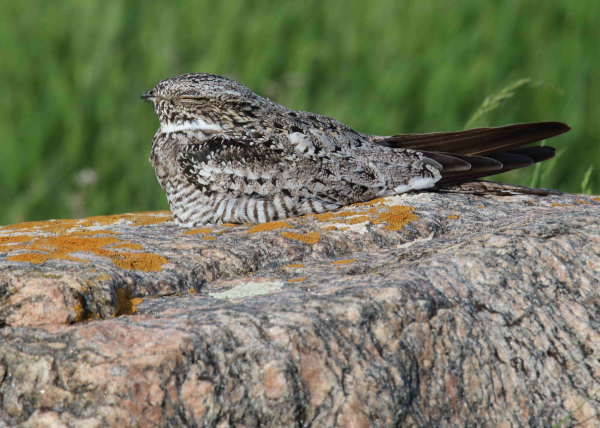
A Common Nighthawk provided impressive flights and photos during a birding drive shared by long-time friends.
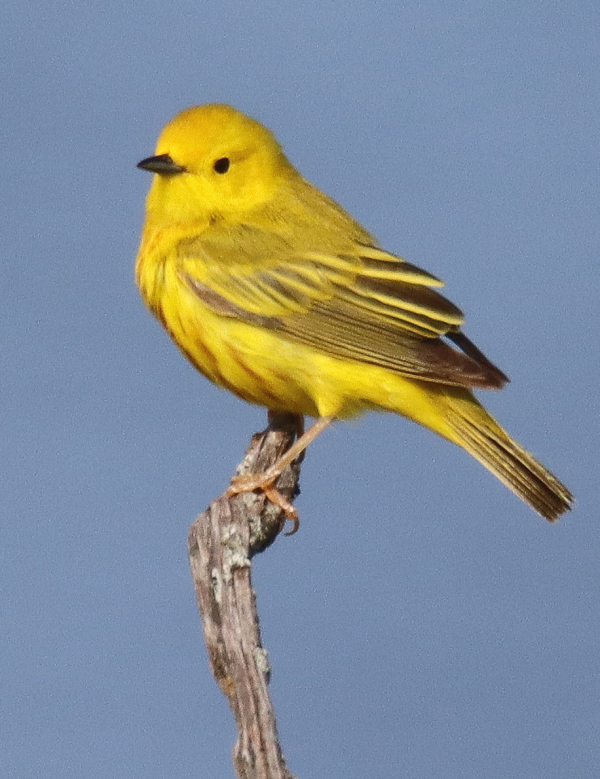
Tom appreciated close binocular views of this Yellow Warbler perched at the edge of an area lake.
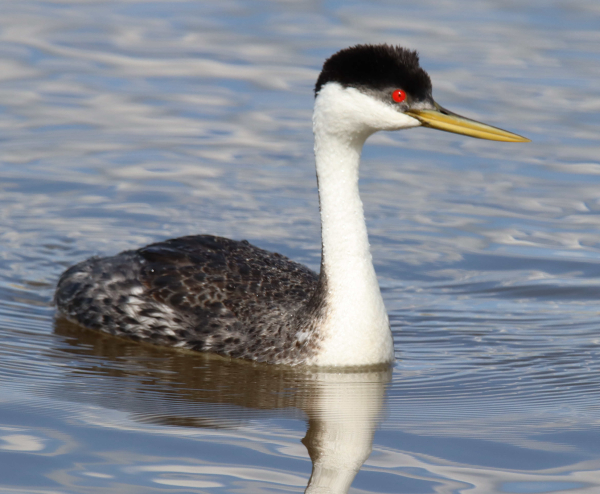
Western Grebes can be seen on many lakes across the Missouri Coteau.
|
A series of 4 birds made my morning Wednesday, while observing the regulars at Melody’s Grove. First, a little brown bird that commanded a second look revealed it was a female Lazuli Bunting – the first female and only the second Lazuli east of the Missouri River region for me. The first male appeared last year at the Grove. Then, at about 20 minute intervals, I sighted a female Magnolia Warbler, the first female of this spring here, while the only other Magnolia, a male, showed up early, weeks ago. Next was an impressive Great Crested Flycatcher, only the second I’ve identified in Dakota; the first appeared at the Grove in 2019. I managed a few documentary photos of it from a distance.
Excited by the mini-migration indicated by the new species – very rare species here – about 20 minutes later, sure enough a small dark flycatcher flew to a perch not far from where the Great Crested was foraging. As it caught my eye, my first impression was that it might be a Willow Flycatcher, but when I reached for my field guide, it was quickly clear this was an Eastern Wood Pewee – my first for the state! I found it especially interesting to see the pewee make a big circular flight during which it looked like a swallow coursing over an open area. WoW, what a morning; mixed with Baltimore and Orchard Orioles, Least Flycatchers and Eastern Kingbirds, a Red-eyed Vireo, a late Swainson’s Thrush, several male Yellow Warblers, and a few American Goldfinches.
The aforementioned Big 4 gave me renewed hope for a late third wave of migrating songbirds and flycatchers. Or were these birds the third wave, extremely reduced in numbers and variety? Time will tell – maybe tomorrow will bring more late migrants – or maybe that’s it: maybe that’s the last hurrah for songbird migration this spring. I’m hoping for and betting on the former – that’s what birders do until proven otherwise.
But Thursday and Friday mornings only the regulars were present at the Grove, although that wasn’t a deal breaker. Then Saturday morning, even the regulars appeared to be gone – no Least Flycatchers, Yellow Warblers, Gray Catbirds; the Grove seemed vacant. Finally a House Wren appeared, and after a period a female Orchard Oriole perched nearby and sang. But there was obviously a big change over the previous day, and previous weeks. Could this signal the end of spring migration at Melody’s Grove? It was a time of reckoning June 4th; and a follow up check the next morning provided more of the same with only a wren song to verify a songbird on hand. It’s always a sad realization, but realistically, it opens up the rest of the northern plains as a birding palate again – onward and upward!
Kansas Kool
I was really happy to have a surprise visit from my friend Tom from Lawrence, Kansas, and it was a highlight to share a birding drive with him to some of the most remote rural areas south of his hometown. The biggest excitement for me was to see 2 new arrivals to the super-green native prairie to the southeast – 2 male Bobolinks, close and in flight. We also saw many Orchard Orioles across the lone prairie, and standouts were an Upland Sandpiper and a Common Nighthawk. The nighthawk was especially difficult to see as it perched low atop a big granite boulder, but it provided some nice photos to share with you.
I had to apologize to the nighthawk though, because I really wanted it to show Tom what a special bird this bird would become in flight after seeing it quite inanimate on the boulder. Not only did it show its sleek aerodynamic form in flight, but it climbed into the sky above the prairie hills and dived, making a little airplane-like sound at the end as it veered upward again. Repeating its “beep” call, it climbed high overhead and repeated it’s dive twice more before we continued down the Lost Road. We also checked the blooming plum trees that were beginning to wain after the big rain, but they were still attracting Orchard Orioles, Least Flycatchers, and Yellow Warblers. At a nearby lake, as Tom watched a striking male Yellow Warbler through binoculars, it picked a prominent bare branch to sing from, which provided a chance for me to photograph it against the pleasing blue water background.
Tom especially enjoyed the flocks of White Pelicans and the variety of ducks, including the primary nesting species: Mallards, Northern Pintails, Gadwalls, Northern Shovelers, Blue-winged Teal, Lesser Scaup, Redheads, and Canvasbacks, although the latter species seems to be in short supply now after so many passed through the area during migration.
Coteau Cruise
Friday afternoon I took to the road, checking favorite birding locations along the way to Bismarck, winding across the Missouri Coteau from end to end. I checked back to the Ferruginous Hawk nest about 20 miles northwest of home where at least 3 medium-sized downy nestlings could be seen on the nest platform while the adult female stood at one end. Eight days earlier I checked the nest and could see a couple small downy nestlings moving clumsily in the nest, so a week’s time made a big difference as these young raptors rapidly mature. This is the nest site that provided memorable photo observations of 4 fledglings last summer, and I hope for more post-fledging observations in a few weeks.
Nearby I appreciated the sight of a Swainson’s Hawk soaring over the low hills of a vibrant green prairie, which gave me hope for seeing more along my route through some of the best Swainson’s Hawk nesting range, the Missouri Coteau, but that was the only one I would see. A week earlier I saw none, and there is definitely something different about the Swainson’s Hawk nesting population this year, and while this species is certainly mobile and reacts to seasonal changes in small rodent populations, the entire region appears to be largely devoid of this elegant migrant from Argentina this season.
Closer to Bismarck, I circled through Long Lake National Wildlife Refuge, and bisected McKenzie Slough and a couple small marshes east of the capitol city. The refuge provided good looks at the usual variety of ducks, along with White Pelicans and Western Grebes, a few Eared Grebes, and a couple standout Caspian Terns. In the ultra-green uplands 2 early Bobolinks were evident, along with a few male Ring-necked Pheasants and a vocal pair of territorial Marbled Godwits. There was also a colony of Cliff Swallows busy collecting mud and building nests under the eves of an historic stone refuge building.
Cliff Swallows were also occupying a bridge at McKenzie Slough, a historic nesting location for these swallows, and I enjoyed photographing a Western Grebe at close quarters in a quiet pool of beautifully colored water. It is a bit surprising that McKenzie’s floodplain is only about half full, considering that every other wetland between my office and Bismarck is filled to capacity, but the Missouri Slope, west of the Coteau is always drier with less seasonal rainfall. Even so, there were plenty of ducks, pelicans, and a few standout Franklin’s Gulls flying low on the hunt, with a few scattered White-faced Ibis present too. Among the cattails, Marsh Wrens were actively in flight as they sang often to establish and maintain territories, along with the usual abundance of Yellow-headed Blackbirds and Red-winged Blackbirds there.
It’s interesting to note that Giant Canada Geese have had a poor nesting year across the region. As of the first week of June, I’ve only seen one small brood of goslings. Granted, it’s been a late year across the northern half of the United States and southern Canada, but I have yet to see a duck brood too, but that’s more of a testament to the season running about 2 weeks later than usual, as emphasized by the late blooming periods of wild plums, chokecherries, and lilacs. Even so, it should be an excellent year for nesting ducks, and broods will begin to appear soon with many more hatching the last week of June and throughout July. Now, the nesting season is in full swing with many lone drakes present among the early nesting ducks – Mallards, Northern Pintails, and even Northern Shovelers, with small groups of Mallard drakes forming too. This indicates the females are incubating, and ducklings will be hatching in time.
Chokecherry Bloom
Considering the good luck I had photographing Orchard Orioles among wild plum blossoms the previous weekend, Saturday evening I wanted to try to take advantage of the new chokecherry blooms, so returned to the same location to see what birds might alight before my zoom lens. There was a big stand of chokecherries right next to the biggest plum thicket, but even closer to where I could position my mobile blind. It’s interesting to note that there were a few Orchard Orioles in the area, but they essentially avoided the chokecherry blossoms, preferring to forage among the fading plum flowers.
I did have good luck photographing birds among the elongated white chokecherry blossoms, and I’ll share the photos and the species that provided a variety of photos in next week’s Bird Photography feature. This week’s feature provides some of the photos I took last week when the plums were in bloom. The weather was beautiful and the air was so fresh while photographing, and I watched a male Northern Harrier in a low hunting flight, heard the calls of the first Grasshopper Sparrows, along with Clay-colored Sparrows, Western Meadowlarks, Yellow Warblers, and more.
I have a big chokecherry bloom in my yard too, but the remaining Orchard and Baltimore Orioles are more actively feeding on grape jelly at my feeding station. There was a considerable migration among the orioles that visit my yard Friday night, but there are still a few Baltimore Orioles on hand and more Orchard Orioles. Perhaps these are the orioles that have taken up summer residence – I hope so. It is also interesting to note that Saturday the first robin began collecting grape jelly along with the orioles, catbirds, and House Finches. Then Monday and Tuesday, one or more newly fledged robins were being fed earthworms and jelly nearby. Ah, the fruits of the nesting season. Enjoy the birds in your yard, your neighborhood, and surrounding areas – it’s a special time of year as the green season prevails!
Article and photos by Paul Konrad
Share your bird sightings and photographs at editorstbw2@gmail.com